

Kylie
The worst forms of child labour (IPEC) Convention No. 182 concerns the worst forms of child labour.
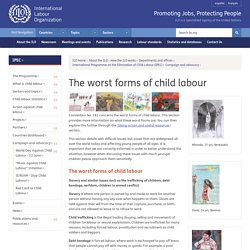
This section provides more information on what these worst forms are. You can then explore this further through the Taking action and useful resources section. This section details with difficult issues, but issues that are widespread all over the world today and affecting young people of all ages. It is important that we are correctly informed in order to better understand the situation, however when discussing these issues with much younger children please approach them sensitively. What Jobs did Children Perform - Child Labor in North Carolina Textile Mills. "The biggest portion of the spinners was kids back then.
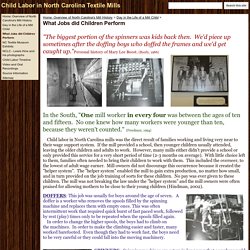
We'd piece up sometimes after the doffing boys who doffed the frames and we'd get caught up. "Personal history of Mary Lee Boost. (Byerly, 1986) In the South, "One mill worker in every four was between the ages of ten and fifteen. No one knew how many workers were younger than ten, because they weren't counted. " Child labor in North Carolina mills was the direct result of families working and living very near to their wage support system. DOFFERS: This job was usually for boys around the age of seven. A doffer is a worker who removes the spools filled by the spinning machine and replaces them with empty ones.
In order to change the higher spools, the boys had to climb on the machines. SPINNERS: Spinning machines are set up in long rows that a worker would walk along and piece up any broken ends. SWEEPERS: This is the job that most boys started with once they "officially" began working at the mill. Health Issues - The Child Labor Education Project.
Working conditions that are safe and healthy for adults may not be safe and healthy for children because of their physical differences.
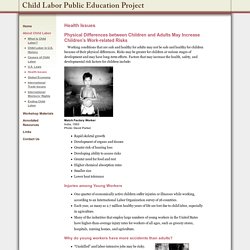
Risks may be greater for children at various stages of development and may have long-term effects. Factors that may increase the health, safety, and developmental risk factors for children include: Match Factory Worker India, 1993 Photo: David Parker Rapid skeletal growth Development of organs and tissues Greater risk of hearing loss Developing ability to assess risks Greater need for food and rest Higher chemical absorption rates Smaller size Lower heat tolerance Injuries among Young Workers One quarter of economically active children suffer injuries or illnesses while working, according to an International Labor Organization survey of 26 countries.
Why do young workers have more accidents than adults? Metal Worker. Child Labor Facts and Statistics - The World Counts. TheWorldCounts, 24 April, 2014 From the Sweat of our Children It’s heartbreaking to think that in this age of technology and communications, where we know everything that’s happening in the farthest corner of the world, child labor is still allowed to exist.
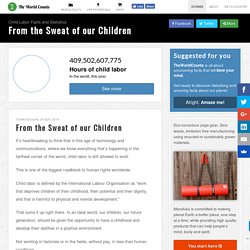
This is one of the biggest roadblock to human rights worldwide. Scholastic News In-depth: Child Labor. How to Help By Karen Fanning When Iqbal Masih was just 4 years old, his parents sold him into slavery to pay off a $12 debt.

For six years, the small boy spent his days crouched over a loom, weaving handmade carpets. Speakers' Spotlight - Craig Kielburger. Speaker Activist | Co-Founder of Free the Children | Co-Founder and Co-CEO of Me to We Craig Kielburger is a social entrepreneur, New York Times bestselling author and captivating speaker, inspiring millions to improve their communities and the world through daily actions.

Craig is the co-founder, along with his brother, Marc, of Free The Children, an international charity, Me to We, an innovative social enterprise, and We Day, a signature youth empowerment event. Craig’s journey as a child rights activist began at the age of 12, when he reached for the morning comics and noticed the newspaper’s front page. The headline read, “Battled Child Labour, Boy, 12, Murdered.” What began as a group of a dozen kids has grown into an international charity. Iqbal Masih and Craig Kielburger: children against child labour. Young people have the power to make a difference The single biggest problem we've had is adults who will not take us seriously, who think that because we are young we will oversimplify the issue of child labour and not do our research.
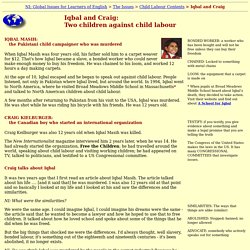
Many of our members are as young as nine or ten years old but we do our research as well as taking action. Child labour is a very complex problem, that's the truth. But that can't be used as an excuse not to take action. Consumer pressure can change things. Does India's new 'Make in India' campaign mean 'Made by Children?' Their hands fly with the speed and precision of veteran assembly-line workers, pausing only to flick sweat from their shiny-smooth foreheads.

They construct box after cardboard box, designed for sari shops in far-off cities, stacking them into multi-hued towers that loom above their small, hunched bodies. Many of the workers are not yet teenagers, and they fill the dimly lighted corridors of the textile mills and warehouses of this industrial city in western India. Despite a law requiring every child younger than 14 to be in school full time, millions of Indian boys and girls still hold jobs, including more than 50,000 in Surat alone, according to estimates by human rights groups. India has declared that it wants to end child labor, but advocacy groups argue that a new government proposal could actually push more youngsters into the workforce, jeopardizing their education and putting them at greater risk of exploitation.
"Suppose I am a shopkeeper. In India, Missing School to Work in the Mine.